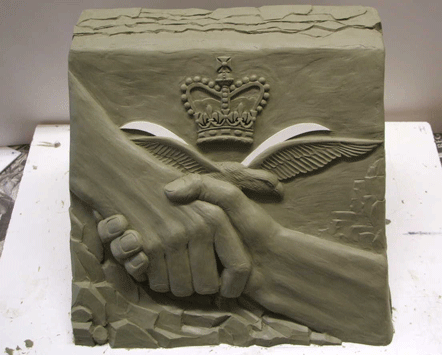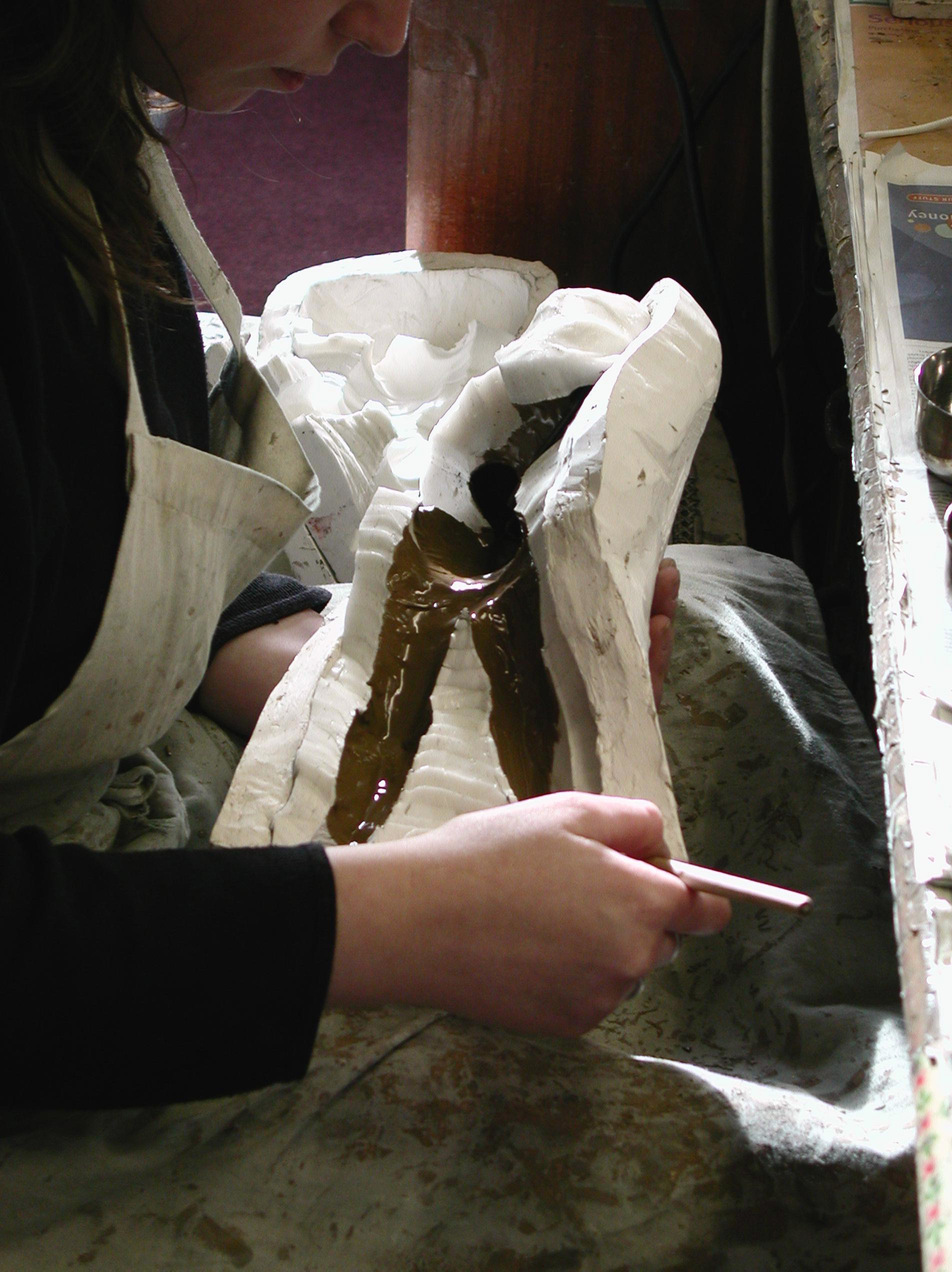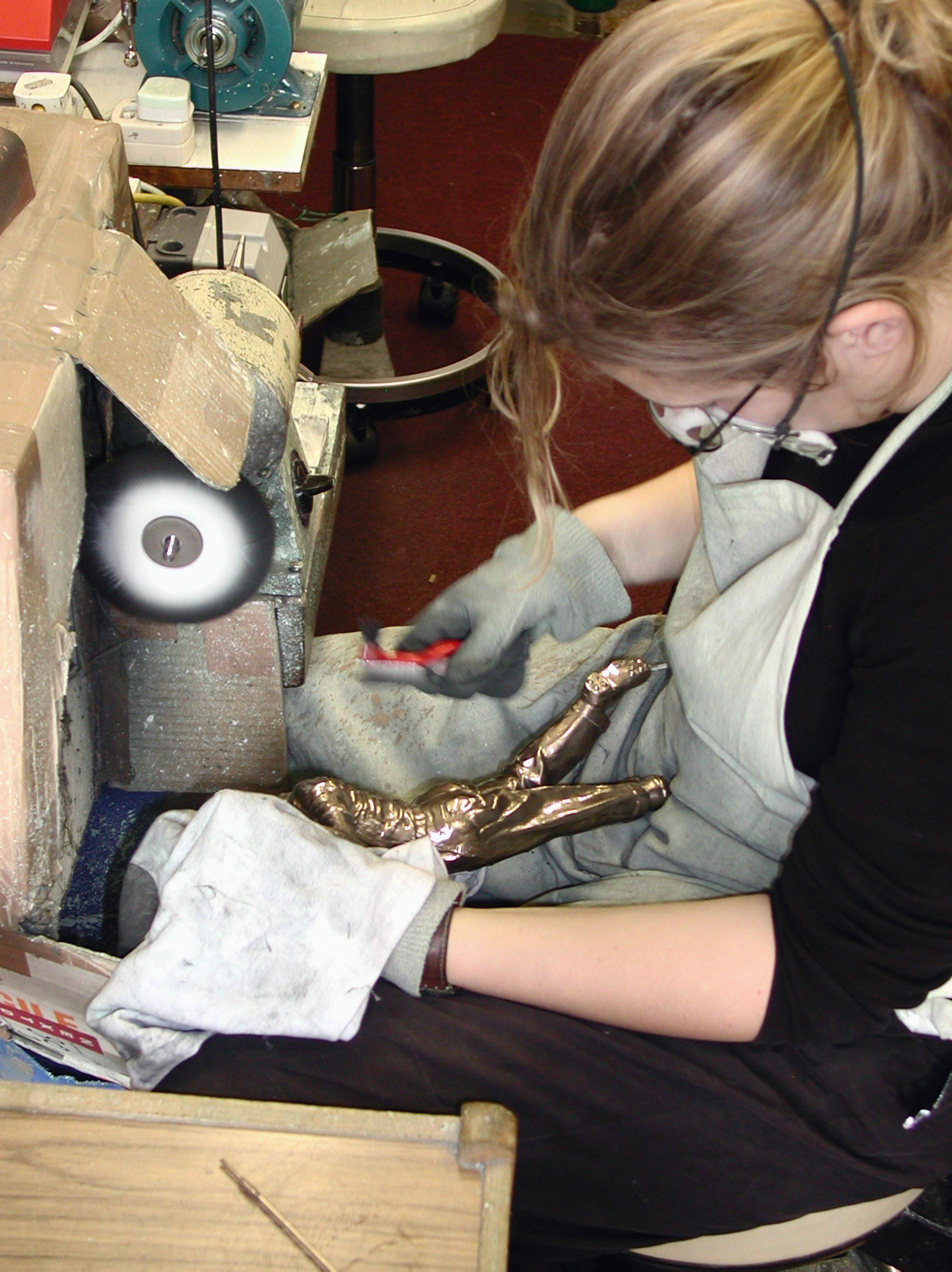


Making your commission is a skilled and complex process, requiring a high level of technical and creative expertise. This section takes you through the various stages to give you an insight into exactly what’s involved in creating something really special just for you or your organisation.
The Brief The process of taking a commission starts with the client’s brief. Detailed discussions take place with the client, to ensure we know exactly what they have in mind. Different people have different starting points – and we can work with you whatever that is.
Thomas & Peters’ in-house artist Ellinor Atkinson creates all the company’s original artworks and trophies. Her first step following agreement about what is required is to sculpt a miniature prototype of the final piece – a model called a maquette. This piece is normally made in clay and may incorporate other materials.
Throughout the process we negotiate with the customer to ensure they understand everything they need to, and we are always happy to answer questions or explain what is going on if required.
The maquette is an important starting point – it gives the client and artist something they can work with together. Further discussions take place and the maquette can be reworked and changed until the client is ready to sign off a final version.
We now have the piece that will be converted to a full size original, then cast to create the final piece
Scaled Prototype The artist now moves on to the major task of creating a full-sized piece – an up-scaled model of the signed-off prototype. This is often involves both a feat of engineering, as well as requiring a very special creative approach.
While the artist is working on the full-size sculpture, the client is kept in touch with the process. This allows an opportunity for them to negotiate further adjustments if required.
Mould Making Once the full-size piece is finished and signed off, the next stage is the painstaking and skilled process of creating a mould. This will then be used to cast the final piece.
At Thomas & Peters we make our moulds out of a synthetic ‘rubber’ made of silicone. The material and the process we use allows for the final reproduction to be extremely detailed and accurate, and the mould to be robust and long-lasting.
Initially a thin coat of liquid rubber is painted on to the sculpture. This is left to dry, another coat added, and the process repeated. This continues until a mould of between 0.5- 1 inch thick – depending on the requirements for casting the final piece - has been created.
A rigid casing is then made to keep the mould stable during casting, by adding a layer of Gypsum or Plaster of Paris of about an inch thick to the rubber mould.
We now have a rubber mould with a removable outer plaster coat. This is now divided into sections so it can be removed and used to cast the final piece.
This is rather like creating a three-dimensional jigsaw puzzle – and the final construction ensures the mould can separate in the minimum sufficient number of parts to release the sculpture inside, without damage either to the final casting(s) or the mould.
Bronze Casting For a hand-cast piece created in our studios, Thomas & Peters will use its own unique, registered method of low-temperature casting.
Registered under the Copyrighted name of Float Bronze, this technique has three important benefits:
First, the surface of each casting is very nearly 100% pure bronze - so it polishes up as beautifully as foundry-cast bronze, which is far more expensive due to the processes involved and the high temperatures required. The final item can be finished to the brightest of bronze, which is as shiny as brass, but unlike brass, which is yellow, is a much warmer colour because of the copper content in the bronze alloy.
Secondly, the Float Bronze surface can also be patinated – that is, given a traditional dark finish - again in an incredibly cost-effective way compared to the patinated finish created in a foundry. This finish has been around for thousands of years in and is often seen on monumental bronzes such as the lions in London’s Trafalgar Square. and throughout the sculptural capitals like Italy.
Thirdly, the low temperature specification ensures a long life to the silicone rubber moulds guaranteeing a maximum output of castings from any one mould. This helps keep costs down for clients who want a long run of their commissioned pieces.
Float Bronze casting involves floating micro-spherical bronze particles on and into specific liquid resin and tightly controlling the exothermic reaction temperature during the hardening reaction to maintain the lowest effective temperatures.
The mould is opened up, and each section coated with liquid Float Bronze. Each section has to be coated very quickly as the liquid hardens at a fast pace - which puts great pressure on the caster to get on with the job! The sections of the mould must then be put together whilst each of the seam lines are still fluid, so they meld together to create one piece. The coating of Float Bronze is usually about 4mm thick. The plaster of Paris casing is then fitted around the silicone rubber, and tied so that it remains as one solid support.
When the bronze coating has hardened, the hollow casting is then filled with a liquid resin mixed with ground stone. It is this which gives the final piece its heavyweight feel. Any vulnerable part of the casting – for instance the arms and legs of a sculpture of a person – is reinforced inside with steel armatures.
The casting then has to be left to harden over a given period of time, depending on its size and structure. After this the casting is carefully removed from the mould, and trimming or fettling of the seam lines - and making up any minor casting faults which are an inevitable part of the casting process – is done by hand.
The casting then needs to rest for a number of days to ‘cure’ before it can be polished.
Finishing Whether you want a shiny bright bronze finish, or a darker patinated surface, the first step is to blast away impurities in the Float Bronze casting surface. This is done using a very fine aluminium oxide powder which is blasted at the figure by hand using a specialist machine. A practised eye and steady hand are required to ensure exactly the right result.
After the surface impurities are removed, three stages of high-speed polishing by hand are required, using a polishing machine which uses mops which revolve at about 3000 rpm. Flax and cotton mops of diminishing hardness are used, each applying polishes of diminishing coarseness, and a final cleaning and waxing to give the brightest metal finish available.
It is at this point at this point that the patination process can begin if it is required. This is a chemical process, again done by hand, which turns the bright bronze into the traditional dark surface.
Mounting All our castings are mounted on green or black Lakeland Slate, unless otherwise required by the customer. Our stone mason, Slate Age (www.slateage.com) has been Thomas & Peters’ supplier since the day we cast our first piece 30 years ago. The stone masons are themselves a small family business, now including a second generation carrying on the good work.
Every stone is drilled by hand to receive the fixing studs, which are then cemented in. For perpetual trophies where the customer wishes to award the trophy every year and record the annual winner’s name on it, a 2 inch mahogany base is added, which base is itself a fine piece of craftsmanship, made by hand with beautiful moulded upper edges.
Delivery or Installation A piece such as a trophy or moveable sculpture will be shipped carefully to your chosen address. We pack everything with the greatest of care to ensure maximum protection during transit – even this part of the process is informed by our years of experience!
A large piece, such as a public artwork or outdoor sculpture may need specialist permanent installation. If required we can advise you or project manage this stage.
Aftercare For Thomas & Peters, the delivery or installation of your commission is not the end of our relationship with the customer. We are always at the end of the phone if you have any questions, comments or need assistance with the piece, for instance if you want to know more about its care. If you are unfortunate enough that any damage occurs to your piece once it is in your possession, chances are that we can fix it and you will never know the difference.
Please email or call us to talk about your project:
sales@thomasandpeters.co.uk
01406 363410